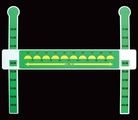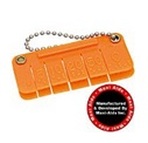- Home
-
Learn
- History of VI >
- Legislation & Laws >
- Vision Professionals >
-
VI Program Resources
>
- Program Printables
- Itinerant Teaching Tips
- Year at a Glance
- VI Program Handbook
- Caseload Analysis
- Organization & Time Management
- Professional Development
- Teacher Standards
- Professional Ethics
- Awards & Recognition
- APH Scholar Program
- Professional Organizations
- Certification Organizations
- Dealing with Challenges
- Professional Publications >
- Relatable Books for All Ages >
- Family Resources >
- Plan
- Basics
-
Teach
- Teaching Strategies >
-
Compensatory Skills Instruction
>
-
Social Skills
>
-
Self Determination
>
- Body Image & Acceptance
- Making Personal Goals
- My Vision Presentation
- My Self-Description
- Create a Personal Data Sheet
- Disclosure Decision
- Disability Statement
- Requesting Help
- Fighting Fears
- My Circle of Support
- Personal Responsibility
- Advocate for Safe Enviroments
- Having Picture Taken
- Coping with Change
- Aging Eyes
- Physical Characteristics
- Political Activism
- Laws Regarding Persons with Disabilities
-
Sensory Efficiency
>
-
Independent Living
>
- Orientation & Mobility Instruction >
- Recreation & Leisure >
-
Career & Vocation
>
-
Grow
- Complete Set Bonus >
-
Recorded Presentations
>
- Webinar: Tips for Being a "Physically Fit" TVI
- Webinar: The Art of Teaching the ECC
- Webinar: Virtual & F2F Strategies
- Webinar: Foundations of Teaching the ECC in the Age of Virtual Instruction
- Webinar: Itinerant Teaching Strategies
- Webinar: Using Themes to Teach the ECC
- Webinar: Conducting a FVLMA
- Webinar: Selecting the Right AT
- Webinar: Developing SMARTER Goals
- Webinar: Determining Service Intensity Using the VISSIT
- Webinar: Activities to Teach the ECC
- Webinar: Accessible Content for BLVI
- Webinar: Accommodations for VI
- Webinar: MIMO Strategies & Activities
- Webinar: SIDPID Strategies & Activities
- Webinar: Standard Course of Study Strategies & Activities
- Webinar: Job Tasks for Job, Career & Life
- Shop
- Jobs
Money IdentificationBy: Carmen Willings
teachingvisuallyimpaired.com Updated October 30, 2017 Accurately, easily and independently identifying money can be challenging for students who are blind or visually impaired. There are strategies and tools available to help the student who is blind or visually impaired learn this important skill. When teaching students to sort and identify coins, it is important to provide hands-on experience with real coins. Coins can be distinguished by feeling the size differences and the smoothness and roughness of the edges. Students need to have repeated experiences in discriminating and using money. Arrange for the student to make purchases from a vending machine, identify stores that sell certain items, schedule fundraising activities, and use shopping lists. Repeated exposure and real-life situations to use money will provide a greater opportunity for learning and applying those concepts.

The Coin Abacus makes counting various combinations of coins and dollar bills simple for students of all ages. This electronic teaching tool helps students of varying educational abilities master the task of counting money. Students will experiment with different coin combinations in order to reach the target amounts on the screen. The coin abacus can be easily adapted by gluing real coins on the abacus.
System for Identifying BillsIn addition to learning to identify coins, it is also important for them
to learn to identify and organize paper money by denomination. This is
considerably more challenging than discriminating coins. If a student is unable to see the numbers on bills, they can use electronic devices that identify bill denominations or they can use a system for marking bills for later identification. The following is a way of identifying bills by the way in which they are folded.
Shopping & BudgetingLearning to shop and maintain a budget are important life skills the student will need if they want future independence. Encourage the student to develop a budget for groceries and meals. Provide the students with opportunities to be a part of creating shopping lists. The lists can be written, brailled, typed or recorded. If you are able to take field trips to the store, plan opportunities to take the students shopping. Otherwise, encourage parents and caregivers to take their child shopping.
Grocery BudgetCreate opportunities for the student to plan, budget and shop for meals with the following objectives:
Budgeting Tips
Additional Resources
Check Writing Guide
Although not too many people continue to write checks, being able to access money and pay bills by writing a check, is an important skill to learn for independence. These check writing guides help students who are blind to fill in each section of a check independently. 
This Money Line, available from Slide-A-Round Math Manipulatives, was developed by Jim Franklin who is a special education teacher. This money number line is accessible to students with low vision as well as those who are blind.
Money Identifier AppsOther Ways to Identify MoneyThere are now other ways to identify money including electronic devices that can identify bills, as well as an app on the iPad/iPhone!

The Pocket Money Brailler allows the user to mark $1-$100 bills with braille for identification by pressing the tabs on the corners of the bills.

The iBill Talking Money Identifier is battery operated and identifies current currency. It recognizes all US paper currency in circulation and announces denominations in a female voice. It features easy operation with just two buttons.

The LookTel Money Reader by IPPLEX is currently $9.99. It instantly recognizes currency and speaks the denomination, enabling people with visual impairments to identify and count bills.

Free. The EyeNote app is a mobile device application to denominate Federal Reserve Notes (U.S. paper currency) as an aid for accessibility for people who are blind or visually impaired. Users can have the denomination of a note scanned and communicated back to the user.
|
ECC InstructionTeaching Strategies
Compensatory Skills
Concept Development
Alternative Communication
Emergent Literacy
Access Print
Access Environmental Print Pre-Braille
Braille Code
Braille Formatting BraillewriterSlate & StylusTactile Graphics
Assistive Technology
VI AT Printables Basic UseProblem Solve Braille NotetakeriOS/Tablet
Windows KeystrokesWord ProcessingProductive Online VI AT Resources Social Skills
Social Skill Needs Non-Verbal Skills
Self Determination
Self Determination Skills
Sensory Efficiency
Sensory Input Sensory Areas & RoomsAuditory ReadinessVisual Efficiency Skills
Independent Living
Personal Care
Hygiene & Grooming
Shopping & Consumerism
Orientation & Mobility
Recreation & Leisure
Career & Vocational
Job Awareness
|
|
Teaching Students with Visual Impairments LLC
All Rights Reserved |
- Home
-
Learn
- History of VI >
- Legislation & Laws >
- Vision Professionals >
-
VI Program Resources
>
- Program Printables
- Itinerant Teaching Tips
- Year at a Glance
- VI Program Handbook
- Caseload Analysis
- Organization & Time Management
- Professional Development
- Teacher Standards
- Professional Ethics
- Awards & Recognition
- APH Scholar Program
- Professional Organizations
- Certification Organizations
- Dealing with Challenges
- Professional Publications >
- Relatable Books for All Ages >
- Family Resources >
- Plan
- Basics
-
Teach
- Teaching Strategies >
-
Compensatory Skills Instruction
>
-
Social Skills
>
-
Self Determination
>
- Body Image & Acceptance
- Making Personal Goals
- My Vision Presentation
- My Self-Description
- Create a Personal Data Sheet
- Disclosure Decision
- Disability Statement
- Requesting Help
- Fighting Fears
- My Circle of Support
- Personal Responsibility
- Advocate for Safe Enviroments
- Having Picture Taken
- Coping with Change
- Aging Eyes
- Physical Characteristics
- Political Activism
- Laws Regarding Persons with Disabilities
-
Sensory Efficiency
>
-
Independent Living
>
- Orientation & Mobility Instruction >
- Recreation & Leisure >
-
Career & Vocation
>
-
Grow
- Complete Set Bonus >
-
Recorded Presentations
>
- Webinar: Tips for Being a "Physically Fit" TVI
- Webinar: The Art of Teaching the ECC
- Webinar: Virtual & F2F Strategies
- Webinar: Foundations of Teaching the ECC in the Age of Virtual Instruction
- Webinar: Itinerant Teaching Strategies
- Webinar: Using Themes to Teach the ECC
- Webinar: Conducting a FVLMA
- Webinar: Selecting the Right AT
- Webinar: Developing SMARTER Goals
- Webinar: Determining Service Intensity Using the VISSIT
- Webinar: Activities to Teach the ECC
- Webinar: Accessible Content for BLVI
- Webinar: Accommodations for VI
- Webinar: MIMO Strategies & Activities
- Webinar: SIDPID Strategies & Activities
- Webinar: Standard Course of Study Strategies & Activities
- Webinar: Job Tasks for Job, Career & Life
- Shop
- Jobs





